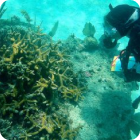
By: Kyle Grammatica
Looking for an outdoor activity for the holiday weekend? Try bay scalloping, it can be enjoyed by people of all ages and snorkeling experience levels.
Scalloping Season Information
Before you go, it’s important to check the dates for the county you plan on scalloping in.
- Gulf County: August 16 – September 24
- Franklin, Wakulla, Jefferson, and NW Taylor County: July 1 – September 24
- Dixie and remaining Taylor County: June 15 – September 7 (Labor Day)
- Levy, Citrus, and Hernando counties: July 1 – September 24
- Pasco County: July 17 – July 26
After checking the season dates, round up the following:
- Saltwater fishing license: A saltwater fishing license is required to harvest scallops unless you are exempt. A no-cost shoreline fishing license can be used in cases where you are scalloping from the shore and not using a snorkel, SCUBA, or boat.
- Snorkeling or Diving equipment: Equipment like a snorkel, mask, and flippers can help you when searching for scallops.
- Diver-Down Warning Device (Dive Flag): If you’re snorkeling or SCUBA diving while harvesting bay scallops, you need to place a dive flag or other diver-down warning device within 300 feet of you. This alerts boaters to your presence and lets them know they need to reduce their speed.
- Landing/Dip Net: Harvesting scallops is only allowed by hand or by using a landing or dip net. If you’re not confident using your hands to collect scallops, a net can be a big help!
About Bay Scallops
Bay scallops are bivalves, meaning they have two valves, or shells, joined by a hinge. Bay scallops’ upper shells are a dark color and the lower shell is typically white; on rare occasions both shells are bright yellow or orange. Bay scallops can reach a shell height of 3.5 inches and live up to two years, but in Florida they rarely grow larger than 3 inches or live more than one year. Bay scallops feed by opening their shells and filtering small algae and organic matter from the water. They will also open their shells when breathing, using their gills to get oxygen from the water. Their shells provide protection from predators and prevent silt from clogging their gills.
Bay scallops have lots of small, blue eyes lining the outer rim of the shells that help detect movement and serve as a warning system. When threatened, bay scallops can swim backwards by contracting and relaxing their large adductor muscle to open and close its shells. This thrusts out water and propels scallops off the bottom and away from danger.
Historically, bay scallops were found from West Palm Beach on the Atlantic coast to Pensacola in the northwest. However, their current range has decreased significantly. Bay scallops are sensitive to environmental changes like seagrass loss, increases in fresh water, and loosening of sediments; big changes can result in population collapses. Harvestable populations are monitored by biologists to make sure their numbers remain stable.
To learn more about bay scallops and scalloping regulations, visit the Florida Fish and Wildlife Conservation Commission’s website. To help protect Florida’s wildlife for generations to come, donate here.











